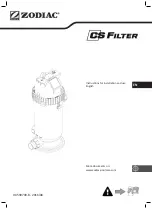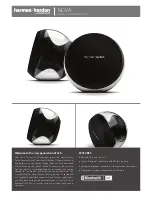
7.
Inspect the valve body by holding it up to
the light. Examine the valve body for cracks.
A black o-ring is located on the valve cap at
the base of the threads. Closely examine the
cavity the valve stem occupies. It should be
smooth. Replace the valve if there are any
nicks or gouges in valve body. Inspect the
valve stem for wear. Focus on the black
rubber seat located at the base of the stem. It
should be smooth. Replace valve stem if
there are any nicks or gouges. A small black
o-ring is located at the head of the stem.
8.
Before reassembling the control valve
lubricate the valve stem with a liberal amount
of petroleum jelly.
9.
It’s important to tighten the brass screw
at the end of the valve stem.
10.
Insert the stem followed by the spring
into the valve body. Tighten the valve cap with
your hands. DO NOT use a wrench. Nelson
sells internal valve components or the entire
valve as replacement parts. Refer to your
parts list when ordering parts.
11.
When replacing the control valve make
certain water flows through the valve in the
proper direction. Otherwise it will not shut-off.
Connect the water supply tube to the IN port
on the control valve and the copper water
spout tube to the OUT port.
12.
When reassembling the pivot beam and
cage to the cross beam it is much easier to
insert the brass pivot shaft with the lead
weight and control valve adjustment screw
removed.
13.
Now adjust the control valve and your
problems with dripping and overflow should
be fixed.
Large Cold Water Filter:
If your water
contains large amounts of debris, and/or if
you have a large number of waterers,
install one large cold water filter at a
convenient non-freeze location. Consult a
licensed plumber.
Flush Waterline Before Installation.
If
waterline is not thoroughly flushed, the
inline filter will clog and the control valve
may not seal, resulting in dripping and
overflow.
FREEZE-UP
If it is a cold day and the waterer is not
refilling or there is ice in the drinking bowl, it is
likely that freeze up has occurred. Follow the
steps below to isolate and resolve the freeze-
up problem.
1. INSPECT ELECTRICAL CIRCUIT
A.
Freeze-up may be the result of a blown
fuse or tripped circuit breaker. If a fuse has
blown or a breaker has tripped, there may be a
safety issue with the circuit. DO NOT turn
electrical power on to the waterers until a
licensed electrician has inspected the circuit.
Keeping electrical power OFF to the circuit will
eliminate risk of electrocution.
B.
Freeze-up may be the result of not having
the electrical power switched on to the
waterer. This is common during the first cold
weather of the season as it is recommended
that electrical power be turned off to waterers
during non-freezing months. Sometimes the
electrical circuit is not turned on for a new
installation.
C.
Nuisance tripping from Ground Fault
Interrupters (GFIs) may cause freeze-up. If
GFIs are used, it is best that each waterer be
on its own individual electrical circuit so as to
reduce nuisance tripping.
NEXT STEP
- If it is verified that there is
electrical power to the waterers go to Step
2 - “Inspect Waterer”.
2. INSPECT WATERER
A.
Remove the top cover and drinking bowl
to visually inspect the heater. If temperatures
are below freezing, the heater should be
cycling, turning off and on. The colder the
outside temperature the longer the heater will
remain on during the cycle. If the heater is
working, the crossbeam under the drinking
bowl should be warm or even hot to the
touch, so be careful. You may see a red glow
under the cross beam as the heater can
become red hot.
NEXT STEP
- If there is electrical power to
waterer and heater is not cycling, go to
Section “Test Heater & Thermostat”.
NEXT STEP
- If the heater is cycling but
water is not refilling, go to Step 3 – “Other
Causes for Freeze-Up”.
3. OTHER CAUSES FOR FREEZE-UP
A.
Brass Shut-Off Valve & Water Supply
Hose Location (See diagram on page 9.)
Failure to install the shut-off valve and water
supply hose in the proper location may result
in freeze-up and the inability to shut-off the
water supply and service the inline water filter.
Relocate brass shut-off valve and water supply
hose if originally installed incorrectly.
B.
Inadequate Heat Well Size
The most efficient method used to protect
the riser pipe from freezing is to utilize the
earth’s heat. Ground heat is obtained by
digging a hole, otherwise known as a heat well
directly below the waterer. The earths heat
naturally rises and circulates around the
waterline protecting it from freezing. The wider
& deeper the heat well, the more ground heat
can be obtained. Freeze-up can occur if the
heat well is not large enough. Installation
instructions state, that when using ground
heat to protect the riser pipe from freezing. It is
necessary to extend an 8 to 10 inch diameter
5
Brass Hex Nut
Valve
Body
Valve Cap
Valve
Stem
Brass Screw
O-ring
Black O-ring
Control
Valve
Complete
Ports are
labeled
“IN” and
“OUT”
Control
Valve
Port
Q
u
estio
n
s?
Pho
n
e: 888-844-6606
www.
n
elso
nm
fg.co
m
Mo
n
day-F
r
iday 7:30-5:00 CST






























